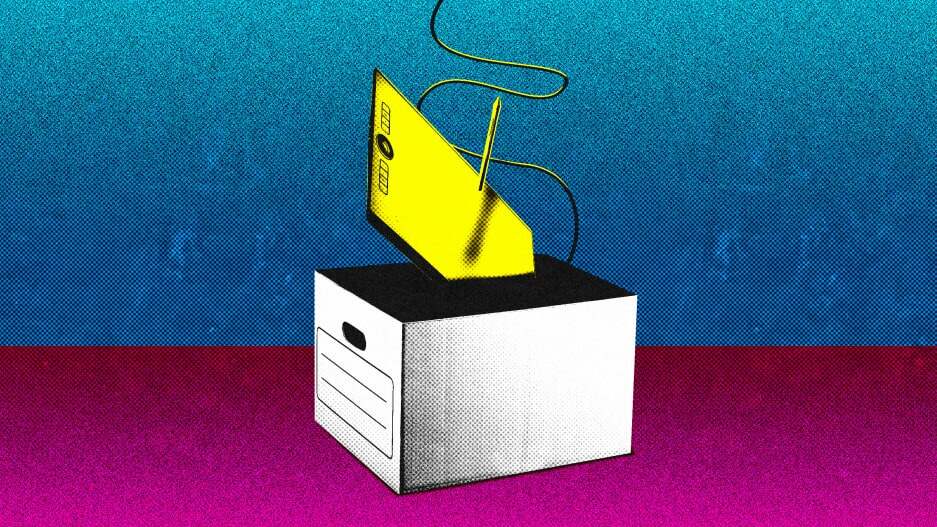- | 8:00 am
What do the Big Tech layoffs mean for designers?
As Google, Amazon, Microsoft, and Meta slash their head counts, designers have been among the workers let go. Could so much talent fresh on the job market lead to a renewed era of design innovation?

“Make no mistake, this layoff isn’t about low performers.”
Judy Wert leans over her laptop, her head in her hands, cataloging the emails, text messages, and phone calls she’s received in the past week from friends, clients, and colleagues. This is her new normal in the wake of layoffs across Google, Microsoft, Meta, Amazon, IBM, and elsewhere.
“Our inboxes are overflowing,” she says.
Wert & Co. is a 28-year-old bicoastal firm run by mother-son team Judy and Daniel Wert that helped pioneer executive search in both tech and design disciplines. The firm sits at the nexus of a story that began with news of tech layoffs at Salesforce the first week of the year.
“The last 10 years, there’s been a lot of over-hiring,” Daniel Wert says. “Valuations haven’t been grounded in reality. There’s been amazing hope and bullishness. And that translated to exuberance and the opposite of fiscal conservatism. The writing has been on the wall. But even if you notice it, most tea leaves feel pretty impersonal.”
A tally by entrepreneur Roger Lee shows that nearly 60,000 people in the tech industry have been laid off since the start of the year. While there’s no available data on how design teams specifically have fared (Google, Amazon, Meta, and Microsoft declined to offer specific numbers), a quick loop around Twitter or LinkedIn provides context on the layoffs, which seem to run wide and deep across companies.
Powerhouse designer Rob Giampietro posted on Twitter that he was one of many laid off from Google’s Insights+Innovation team, which focuses on UX strategy. Computer science whiz, designer, and search pro Dan Russell wrote on LinkedIn, “I found out when I went to work at 4 a.m. to finish up an important analysis, and my badge didn’t work. After 17.5 years at Google, it was kind of a tough way to discover that I’d become a Xoogler. I still believe that Google’s got a great mission. I still believe in #TheJoyOfSearch, but my enthusiasm was a little tempered this morning.”
The recent layoffs nudge at the question of where design falls in the landscape of the larger business world. It’s a particularly pertinent question as businesses decide how and where to spend their dollars in a moment of belt tightening.
In the past decade, design as a discipline has undergone a rebrand: No longer seen as finish and color, it’s been considered by many companies an integral part of business, necessary for innovation, strategy, and problem-solving. At the same time, design’s corporate star has inarguably faded as it becomes a more ingrained part of companies’ playbooks.
But if innovation teams are among some of the first to go, what does that mean for design’s place in strategy and growth? And if design does, indeed, have a seat at the table, does that also mean it has a more prominent place on the chopping block when the economy tightens up?
In recent years, tech companies have been hiring design and tech talent at a record pace, with some reportedly doubling head count during the pandemic and others scaling up more than 50%. In a May 2022 episode of his podcast Pivot, author and New York University business professor Scott Galloway called it. He predicted that this recession would be bad for “white Patagonia-vested workers, information-age workers,” saying that “the unicorn stable is about to get ugly.”
Now, of course, those estimations are playing out in real time as macroeconomic forces tamp down growth and expansion in places where until recently cash was cheap and bright ideas and jobs were plentiful. As companies tighten their corsets, says Daniel Wert, they’re homing in on teams that are working on projects with immediate ROI, choosing to lay off those who aren’t specifically focused on a return in the very near term.
How that plays out remains to be seen. Will these cuts save the day when things potentially turn sour months from now? Or did some of these companies let go of the talent that would have pushed forth the big idea that fuels the next upswing? Either way, there’s reason to think this is just the beginning of 2009 2.0. Only this time there’s social media, millennials who’ve never been to this rodeo, and countless high-performing tech and design brains unleashed into the market. What’s next, though, is perhaps the more interesting and optimistic aspect of this story.
For Mia Blume, who runs San Francisco-based Design Dept. and spends her days training executives and design leadership at organizations like Dropbox, Google, Uber, Lyft, and Facebook, these layoffs do present some silver lining. “There is this really interesting opportunity for the design community to engage in business in a way that we’ve been slowly inching toward,” Blume says. “This is an opportunity for us to show that the value of our work is much more closely tied to the core of business. We can help shape the future. We don’t have to be the ones who sit off in R&D labs to do innovation.”
While the recent layoffs have seemingly hit most departments, Blume notes that companies are still investing in design. At the end of 2022, Design Dept. conducted a survey of more than 300 design leaders at public tech companies, startups, agencies, and non-tech companies. Roughly 45% of respondents said their companies were cutting costs but that learning and development was one of the line items least affected. “We are still supporting plenty of designers and design teams,” she says. “One of the most popular workshops we are teaching right now—including inside organizations that have done layoffs—is our designing business series.”
By the same token, the team at Wert & Co. is simultaneously supporting designers who have been laid off and helping its clients fill roles across the industry. “Our work is to take care of the community,” Judy Wert says. “Is that a search or is that to help someone out? However we can be helpful. I feel like I should be taking every single call.”
Industries that haven’t necessarily gone through a conversion toward design can take advantage of the moment, too, and make some key hires. In fact, GM released a statement this week that it plans to hire at least 8,000 tech workers. Finance, healthcare, government, and manufacturing, says Blume, are prime examples of “digital adjacent” industries where there’s tremendous room for innovation.
Doug Powell, a design executive with 30 years in the industry, including leading the 1,000-plus-person design team at IBM, agrees. “If I’m running a midsized company—transportation, shipping, government services, the public sector, manufacturing—I’m looking at the talent market of designers and digital transformation professionals,” he says. “Wow, there is an opportunity to really accelerate digital transformation by investing in a level of talent that hasn’t been available before.”
Daniel Wert is also quick to note the power of what he calls “forced courage.” He says that in the period following such wide-sweeping cuts from tech’s biggest players, pent-up creatives could produce a few truly world-changing startups. “Innovation is often a symptom of lack of choice,” he says. “Pressure creates diamonds.” Judy Wert adds, “What came out of the housing collapse? Airbnb, Slack, Uber. When the Nasdaq crashed in 2000? Facebook, Twitter. The internet bubble in 1995? Amazon.”
Cameron Rout, a product manager at Google, wrote on LinkedIn last week: “GOOGLE LAYOFF STARTUP! Who’s in? . . . We need to capture this energy. Not just Google, but the whole sector. Let’s all ‘do coffee,’ let’s chat, let’s share ideas, let’s be there for each other.” The ensuing commentary of nearly 600 responses was pretty invigorating to read, with Rout noting that within a few hours he’d connected with at least 100 new people.






































